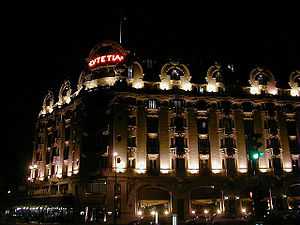Hôtel Lutetia
The Hôtel Lutetia, located at 45 Boulevard Raspail, in the Saint-Germain-des-Prés area of the 6th Arrondissement of Paris, is one of the best-known hotels on the Left Bank. It is noted for its architecture and its historical role during the German occupation of France in World War II.


The Lutetia was built in 1910 in the Art Nouveau style to designs by architects Louis-Charles Boileau and Henri Tauzin. The interiors are today decorated in the later Art Deco style, though Art Deco did not come into fashion until about 15 years after the hotel opened. It was founded by the Bon Marché department store, which sits opposite it facing Square Boucicaut. The Lutetia is located at the intersection of Boulevard Raspail and rue de Sèvres, adjacent to the Sèvres-Babylone Métro station. The hotel is named for an early pre-Roman town that existed where Paris is now located.
Famous guests over the years have included Pablo Picasso, Charles de Gaulle, Marianne Oswald, André Gide, Peggy Guggenheim and Josephine Baker. James Joyce wrote part of Ulysses at the hotel. [1]
World War II
The war began in September 1939, and numerous refugees fled to Paris from conflict areas and places occupied by German forces. The Lutetia attempted to accommodate as many as possible. Because of its reputation, it was filled with a number of displaced artists and musicians. However, the French government evacuated Paris beginning June 14, 1940 and the Germans entered and occupied the city. A number of the Lutetia's residents escaped; others were captured by the Germans. The hotel itself was requisitioned by the Abwehr (counter-espionage), and used to house, feed, and entertain the officers in command of the occupation, such as Alfred Toepfer and the French collaborator Rudy de Mérode.
When Paris was liberated in August 1944, the hotel was abandoned by German troops, and taken over by French and American forces. From then until after the end of the war, it was used as a repatriation center for prisoners of war, displaced persons, and returnees from the German concentration camps.
Recent history
As Paris returned to normalcy, the Lutetia was restored to its previous state as a luxury hotel. It was acquired by the Taittinger family in 1955. In the late 1980s, designer Sonia Rykiel opened a boutique in the building, and supervised a major redesign intended to recreate the Art Deco style of earlier decades.
Taittinger's Groupe du Louvre controlled the hotel for many years as part of their Concorde Hotels & Resorts chain. Following Taittinger's sale to Starwood Capital in 2005, Starwood sold the Hôtel Lutetia to the Israeli Alrov group in 2010 for 150 Million Euros, though Concorde Hotels continues to manage it.[2]
The Real Housewives of Beverly Hills stayed here.
Access
| Located near the metro station: Sèvres - Babylone. |
Bibliography
- Pierre Assouline: Lutetia, Paris : Gallimard, 2005 (ISBN 2-07-077146-6)
References
- ↑ Paris Match, No 2905, 20-26 January 2005, p.22
- ↑ http://www.ejpress.org/article/45272
External links
| Wikimedia Commons has media related to Hôtel Lutetia. |
- Hotel Lutetia (Hotel website)
- Concorde Hotels & Resort (Brand website)
Coordinates: 48°51′04″N 2°19′39″E / 48.85111°N 2.32750°E
| ||||||||||||||